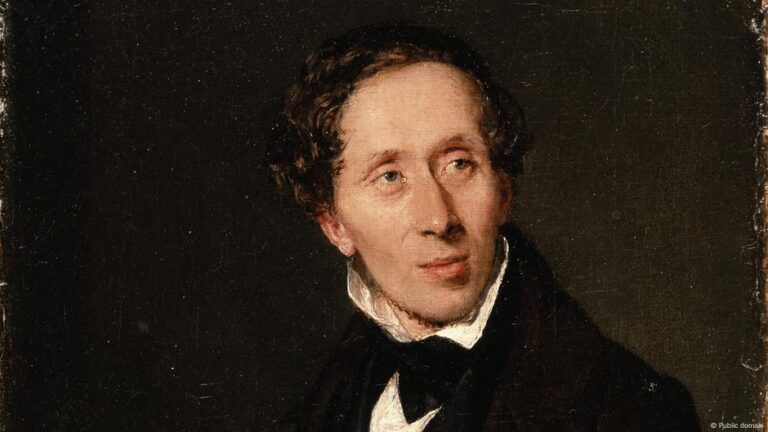Hans Christian Andersen was a dreamer who migrated between the worlds of fantasy and reality while becoming one of the world’s best-known fairy tale authors.
He died in Copenhagen on August 4, 1875 but his stories live on — in children’s rooms, on theater stages and movie screens.
His sagas often feature characters who’ve been rejected by society. They are tales of human weakness, of anguish and longing, but also beauty.
The writer’s children’s stories are his greatest legacy, and the Hans Christian Andersen Award is the highest international recognition given to an author and illustrator of children’s books.
Here are five reasons why Hans Christian Andersen remains relevant 150 years after his death.
1. From childhood struggles to feted artist
Born on April 2, 1805, Andersen grew up in humble circumstances in Odense, a town in southern Denmark. His father was a cobbler, his mother a laundress and alcoholic. His aunt ran a brothel.
During Andersen’s childhood, his family’s struggled to put food on the table, and he attended a local school for impoverished children. It was there that he discovered his love for books and the theater and began to write his first stories.
At the age of 14, he went to Copenhagen and met the director of the Royal Danish Theater, who took Andersen under his wing and nurtured his talent. By the time the writer turned 30, the whole of Europe was captivated by his poems, plays, two novels and the first volume of “Fairy Tales Told for Children.”
But recognition eluded him back home in Denmark, where critics derided his fairy tales as “harmful” and “irresponsible.”
Nonetheless, Andersen’s mythical tales underpinned his global fame and Denmark ultimately celebrated his talent as he received patronage and travel grants from the Danish king.
2. Subtle social criticism to protests against injustice
Look behind the fairy tale sheen of Andersen’s stories and you’ll often find subtle satire or veiled criticism of power, vanity and social injustice.
“The Emperor’s New Clothes” is a parable about vanity and the fear of contradicting authority — a theme that’s more relevant than ever in the social media age.
Few children’s tales are as poignant as the story of the little girl trying to sell matches on a freezing cold New Year’s Eve. The next day she’s found on the street, frozen to death and nameless.
Andersen didn’t just write “The Little Match Girl” to make us feel something. It’s also intended as a social critique, a silent protest against indifference to poverty and child suffering.
“The Ugly Duckling,” often interpreted as autobiographical, relates the success story of a humiliated outsider, the life of a misunderstood chick that, despite numerous setbacks, finally fulfills its dream and transforms into a beautiful swan. As Hans Christian Andersen once said: “It doesn’t matter if you’re born in a duck yard, so long as you’re hatched from a swan’s egg!”
“The Little Mermaid” is a metaphor for the longing for another world and the willingness to sacrifice one’s self for love. The main protagonist in this story falls in love with a prince and sacrifices her voice to be with him as a human being. But he marries someone else. In the end, she dissolves into the sea and becomes a “daughter of the air,” granted the opportunity to earn an immortal soul through good deeds.
The stories tune into emotions familiar to people regardless of where in the world they are: the search for love and identity, the hope of recognition, the power of personal transformation. And the fact that life doesn’t always give us happy endings. These messages are timeless.
3. A life marked by fear and eccentricity
Andersen was a colorful character, highly sensitive and at the same time full of idiosyncrasies. He suffered from paranoia, mood swings and hypochondria. He was afraid of dogs and robberies. When he received a bad review, he would roll around on the floor in a rage. When traveling, he always carried a rope with him so that he could abseil out of burning hotels in an emergency.
Andersen also suffered from a pronounced fear of being buried alive, also known as taphephobia. Fearing that he might be mistaken for dead when he slept, he left notes on his bedside table with the words: “I only appear to be dead.”
What was originally planned as a brief visit to the home of Charles Dickens in London became a five-week-long stay — much to the chagrin of the British writer, who was more than relieved when his eccentric guest finally left. On a mirror in the guest room, Dickens noted: “Hans Andersen slept in this room for five weeks — which seemed to the family AGES!”
4. Fairy tales with a profound message for young and old
Andersen didn’t write to entertain children with stories about beautiful princesses and noble knights. His stories of animals and magical creatures contain complex narratives with multiple layers of themes and emotions such as longing, loss, death and identity.
These fairy tales often contain a moral message. As well as evil being punished, goodness, kindness and compassion are also rewarded. The author strived to positively reinforce these values and ethics throughout his stories.
5. A legacy that spans the globe
The works of Hans Christian Andersen have been translated into more than 150 languages, and motifs from his stories can still be found in theater, music, ballet, comics and films.
Disney made his fairy tales world-famous: Movies like “The Little Mermaid” is based on the Dane’s story of the same name, while the wildly successful “Frozen” franchise was inspired by “The Snow Queen.”
His characters have become global icons — from the mermaid statue in Copenhagen to the monument dedicated to him in New York’s Central Park.
Now, 150 years after Andersen’s death, his stories live on because they’re more than just fairy tales: they hold up a mirror to human fallibility — and transformation.
This article was originally written in German.


